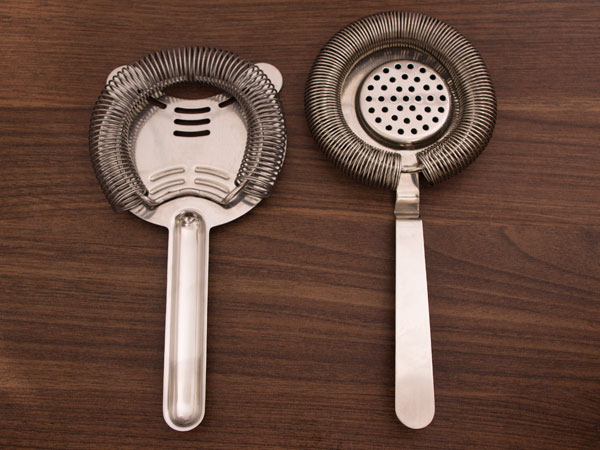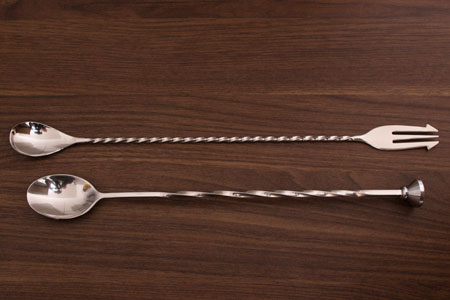Another week of The Right Tools is here and it's time for some quick information about strainers and bar spoons. Two essential tools when using mixing glasses or boston shakers, so let's take a closer look at them.
Similar to buying shakers and glasses, spending a bit more on a good quality product will benefit you in the long run. I have a cocktail strainer which I bought almost 10 years ago. It still looks good and is without any faults. The same goes for one of my bar spoons. Getting something durable will pay off in the long run.
Cocktail Strainers
Pictured below are my two cocktail strainers. The left one is an Alessi strainer made from 18/10 stainless steel. It is the aforementioned 10 year old strainer, that has been by my side for quite some time, while still looking nice and shiny.

The other one was acquired much more recently. Being smaller, it fits into my mixing glass well. I chose it because I can use it with a Boston shaker too, but it was a bit more expensive than a standard julep strainer. Overall, I like the look and it fits well with my other hardware.
If you are searching for a good strainer, I can always recommend an Alessi one. It is expensive, but seeing how many years I have had it, it was quite worth the investment. A strainer made out of stainless steel will surely last you a long time, so this is something to look out for. If you want it nice and shiny, get 18/10 stainless steel.
You can just use one Hawthorn strainer for both, your mixing glass and your Boston shaker. But it won't hurt to spend a bit extra and get a julep strainer too. If you can do without one made from silver, it shouldn't cost a fortune.
Bar Spoons
There are a lot of different bar spoons out there and although I use two different ones, just one is usually more than enough. The spoon with a fork is a Japanese style bar spoon, the other one is the European kind.

Basically there are three kinds of bar spoons: American, European and Japanese. If you want to get something really durable I suggest going for the European kind. Most of the time, they are heavier than their American counterparts and often more versatile. If you want something fancy and stylish, Japanese is the way to go. And if you just want an inexpensive bar spoon that you can use to measure and stir, go for an American version. They do their job just fine and don't cost as much.
So why do all those spoons have different ends? With Japanese spoons it's mostly an aesthetic choice. The fork for example has the purpose of reflecting the light while stirring, thus creating nice reflections. A European spoon with a heavy end can be used to hand-crack ice, while a flat end might help you to layer some cocktails easier, but this is purely optional.
There really is no great advantage in owning one spoon over another, so just get one that you find visually pleasing and be happy with it. If you care about cracking ice or nice reflections of light, chances are you will end up owning more than one spoon anyway.
Final Thoughts
Both tools are rather essential if you intend to make some proper cocktails. They are easy to acquire and not that expensive, which means they are a must for any aspiring mixologist. Like I said before, it really pays off to invest a bit more and get something that will last for years.
There is still one entry planned in this series to cover the last two essential tools everybody needs to build great cocktails. Since I really want to experiment with new cocktails, it probably won't be out next week, but I will try hard not to procrastinate for too long. Check out my Twitter or subscribe to follow along. If you have any ideas for more useful tools, leave a comment and let me know.
Title image via pixabay.